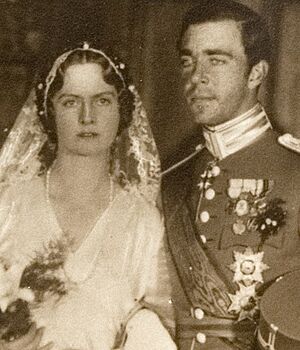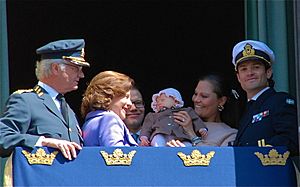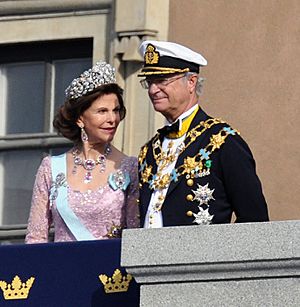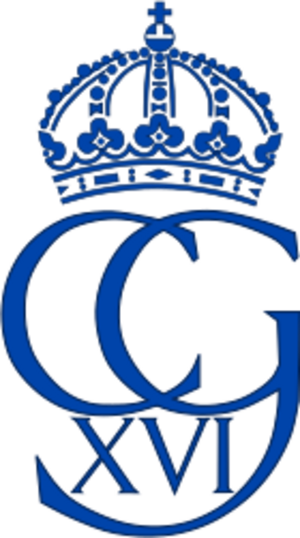Carl XVI Gustaf facts for kids
Quick facts for kids Carl XVI Gustaf |
|||||
|---|---|---|---|---|---|
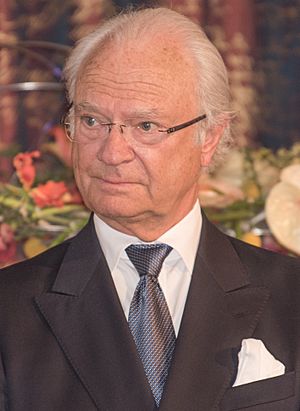
Carl XVI Gustaf in 2018
|
|||||
| King of Sweden | |||||
| Reign | 15 September 1973 – present | ||||
| Enthronement | 19 September 1973 | ||||
| Predecessor | Gustaf VI Adolf | ||||
| Heir apparent | Victoria | ||||
| Prime ministers | |||||
| Born | 30 April 1946 Haga Palace, Solna, Sweden |
||||
| Spouse | |||||
| Issue | |||||
|
|||||
| House | Bernadotte | ||||
| Father | Prince Gustaf Adolf, Duke of Västerbotten | ||||
| Mother | Princess Sibylla of Saxe-Coburg and Gotha | ||||
| Religion | Church of Sweden | ||||
| Signature | |||||
| Education | |||||
| Swedish Royal Family |
|---|
 |
HRH Princess Birgitta Extended royal family
|
Carl XVI Gustaf (born 30 April 1946) is the King of Sweden. He has been king since 1973, making him the longest-reigning monarch in Sweden's history.
Carl Gustaf was born when his great-grandfather, King Gustaf V, was still king. He was the only son of Prince Gustaf Adolf, Duke of Västerbotten, and Princess Sibylla of Saxe-Coburg and Gotha. His father died in a plane crash in January 1947, when Carl Gustaf was just nine months old. When his grandfather, Gustaf VI Adolf, became king in 1950, four-year-old Carl Gustaf became the crown prince, meaning he was next in line to the throne.
Carl Gustaf became king on 15 September 1973, after his grandfather passed away. Soon after he became king, a new law called the 1974 Instrument of Government came into effect. This law changed the role of the king. It took away most of the king's official powers. Now, the king mainly has ceremonial duties. For example, he no longer formally chooses the prime minister or signs laws. He still gets regular updates on important government matters. As the head of the House of Bernadotte, he also makes decisions about royal titles.
In June 1976, Carl Gustaf married Silvia Sommerlath. They have three children: Victoria, Carl Philip, and Madeleine. A new law in 1980 changed the rules for who inherits the throne. It made the oldest child, regardless of gender, the heir. This meant his eldest child, Crown Princess Victoria, became the heir. Her younger brother, Carl Philip, was briefly the heir when he was born in 1979, but the law changed that.
Contents
Early Life
Carl Gustaf was born on 30 April 1946 at Haga Palace in Solna, near Stockholm. He was the youngest of five children and the only son. He was christened on 7 June 1946.
His godparents included many royal family members from Denmark, Norway, and the Netherlands. He was given the title Duke of Jämtland. His father died in a plane crash in January 1947. This made the nine-month-old prince second in line to the throne. When his great-grandfather, Gustaf V, died in 1950, Carl Gustaf became the heir at age four.
Carl Gustaf was seven years old when he learned about his father's death. He has spoken about how it felt to grow up without knowing his father.
Youth and Education
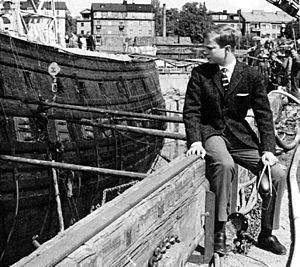
Carl Gustaf first studied privately at the Royal Palace. He then attended Broms school and Sigtuna boarding school. After finishing high school in 1966, he spent two and a half years training in the Swedish Army, Royal Swedish Navy, and Swedish Air Force. He even sailed around the world on a ship called Älvsnabben.
He became an officer in all three military branches in 1968. He also studied history, sociology, political science, tax law, and economics at Uppsala University and Stockholm University.
To prepare for his role as head of state, Carl Gustaf learned about the court system, government, and international affairs. He spent time at the Swedish mission to the United Nations and worked at a bank and the Swedish embassy in London. He has been a strong supporter of the Scout Movement since he was young.
Carl Gustaf has dyslexia, a learning difference that affects reading. His daughter Crown Princess Victoria and son Prince Carl Philip also have it. He has received honorary degrees from several universities.
Reign
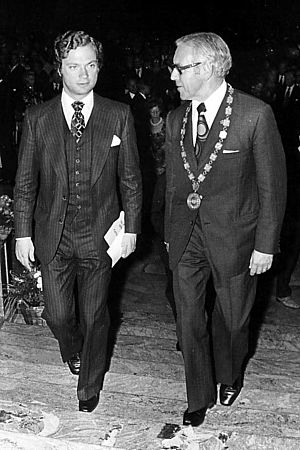
Carl Gustaf became king on 15 September 1973. On 19 September, he officially took his oath during a special government meeting. He then appeared before members of parliament and others at the Royal Palace. He sat on the Silver Throne and gave a speech. Both events were shown live on television.
As head of state, the king represents Sweden. He makes state visits to other countries and welcomes foreign leaders to Sweden. He opens the yearly session of the Riksdag (Sweden's parliament). He also chairs important government meetings and receives ambassadors. Each year, he presents the Nobel Prizes and the Polar Music Prize. He does not vote in Swedish elections.
Carl Gustaf holds the highest ranks in the Swedish Armed Forces. This is because when he became king, the law stated he was the Commander-in-Chief. A new law in 1975 changed this, but he kept his ranks.
On 26 April 2018, Carl Gustaf became the longest-reigning Swedish monarch. He passed the record set by Magnus Eriksson.
Carl Gustaf's Golden Jubilee was celebrated in 2023. This marked 50 years on the throne. The celebrations included tours across Sweden, a banquet, and a parade in Stockholm. While there was some criticism of the monarchy around this time, public support for the royal family remained strong, especially due to Crown Princess Victoria's popularity.
After his cousin, Margrethe II of Denmark, stepped down in 2024, Carl Gustaf became the longest-serving head of state in Europe. His reign saw Sweden join NATO on 18 March 2024, ending over 200 years of neutrality.
Views and Public Role
Carl Gustaf has sometimes shared his opinions on political matters. In 1989, he spoke about Norway's seal hunting. In 2004, after visiting Brunei, he called it an "open country." He repeated this view in 2023, even though Brunei is not a democracy.
After the 2004 Indian Ocean earthquake and tsunami, many Swedes died. The prime minister at the time did not inform the king about the situation as he should have. Carl Gustaf gave a well-received speech at a memorial ceremony in 2005, which helped restore support for the monarchy.
In 2015, Carl Gustaf helped solve a problem between Sweden and Saudi Arabia. Sweden's foreign minister had criticized Saudi Arabia's human rights. The king wrote a letter to the Saudi Arabian king, which helped end the disagreement.
In 2016, Carl Gustaf spoke about a proposed Nobel Center in Stockholm. He said it was "too big and in the wrong place." The plans for the center were later changed.
In December 2020, Carl Gustaf said that Sweden "failed" in its approach to the COVID-19 pandemic. Sweden had not imposed a full lockdown.
In March 2022, the King spoke out against the Russian invasion of Ukraine. He said Europe was in a difficult situation and accused Russia of breaking international law.
In 2023, the Nobel Foundation planned to invite ambassadors from Russia, Belarus, and Iran to the Nobel Prize ceremony. This caused a lot of criticism. The royal court said the king was still deciding whether to attend. Many political leaders also threatened to boycott. The Foundation later changed its decision.
At a ceremony for Sweden joining NATO in 2024, Carl Gustaf called it a "new era" for Sweden's security. In 2025, he spoke about Sweden's security situation. He said that while Sweden was not at war, it could no longer consider itself fully at peace. He also stressed the need for society to be prepared.
Personal Life
Interests
Carl Gustaf cares deeply about the environment, technology, farming, and business. Like many in the Swedish royal family, he loves cars. He owns several Porsche 911s, a vintage Volvo PV444, a Ferrari 456M GT, and an AC Cobra. The first photos of him and his future wife were taken in his Porsche 911. In 2005, he was in a minor car accident, which made headlines. Carl Gustaf and Queen Silvia have attended many Summer and Winter Olympic Games.
Scouting
Carl Gustaf is the honorary chairman of the World Scout Foundation. He often takes part in scout activities in Sweden and other countries. He regularly visits World Scout Jamborees. He attended the 1979 Dalajamb in Sweden, the 2002 World Jamboree in Thailand, and the 2007 World Jamboree in England. He also attended the 1981 National Scout Jamboree in the United States. In 1982, he received the Bronze Wolf, a special award for service to world Scouting. He gave a speech at the closing ceremony of the 22nd World Scout Jamboree in 2011. The band Europe performed "The Final Countdown" for him. King Carl Gustaf also appeared at the 2013 Boy Scouts of America National Jamboree.
Marriage and Family
Carl Gustaf met Silvia Sommerlath at the 1972 Summer Olympics in Munich. She was an interpreter and host. They married on 19 June 1976, at Stockholm Cathedral. The night before their wedding, the Swedish music group ABBA performed "Dancing Queen" as a tribute to the future queen. In 1980, Carl Gustaf and his family moved to Drottningholm Palace outside Stockholm. They still work at the Royal Palace of Stockholm.
King Carl Gustaf and Queen Silvia have three children and nine grandchildren:
- Crown Princess Victoria, Duchess of Västergötland (born 14 July 1977), married to Daniel Westling, with two children.
- Prince Carl Philip, Duke of Värmland (born 13 May 1979), married to Sofia Hellqvist, with four children.
- Princess Madeleine, Duchess of Hälsingland and Gästrikland (born 10 June 1982), married to Christopher O'Neill, with three children.
Prince Carl Philip was born as the heir to the throne. However, a new law was being created at the time of his birth. This law, which took effect on 1 January 1980, made his older sister, Victoria, the heir. This made Sweden the first monarchy to have the oldest child, regardless of gender, inherit the throne. Carl Gustaf expressed that he was not happy about his son losing his position as heir.
Health
In February 2023, Carl Gustaf had a heart procedure using catheter technology.
Royal Decisions
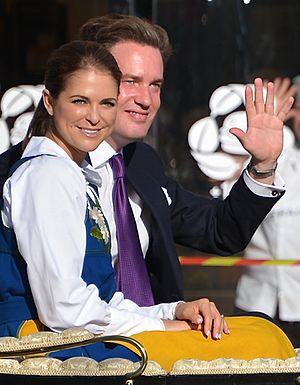
As head of the House of Bernadotte, King Carl Gustaf has made decisions about the titles of his family members since 1973.
- In 1974, his sister Christina married a non-royal. Carl Gustaf followed earlier examples and removed her from the Royal House. She was given the title Princess Christina, Mrs. Magnuson.
- In 1976, when he married Silvia Sommerlath, she became Her Majesty Queen Silvia of Sweden.
- In 1976, his uncle Bertil married. Carl Gustaf made Bertil's wife a Royal Highness Princess of Sweden and Duchess of Halland.
- In 1977, his daughter Victoria was born. In 1980, Carl Gustaf made her Duchess of Västergötland.
- In 1979, his son Carl Philip was born and made Duke of Värmland.
- In 1982, his daughter Madeleine was born. Carl Gustaf created a new duchy for her: Duchess of Hälsingland and Gästrikland.
- In 2010, his daughter Victoria married a non-royal Swede. Carl Gustaf made him a Royal Highness Prince of Sweden and Duke of Västergötland.
- In 2012, his granddaughter Estelle was born and made Duchess of Östergötland.
- In 2013, his daughter Madeleine married a British American who chose not to become a Swedish citizen. Carl Gustaf gave him the special title of Herr (Mr.) Christopher O'Neill.
- In 2014, his granddaughter Leonore was born and made Duchess of Gotland.
- In 2015, his son Carl Philip married a non-royal Swede. Carl Gustaf made her a Royal Highness Princess of Sweden and Duchess of Värmland.
- In 2015, his grandson Nicolas was born. Carl Gustaf created a new duchy for him: Duke of Ångermanland.
- In 2016, his grandson Oscar was born and made Duke of Scania.
- In 2016, his grandson Alexander was born and made Duke of Södermanland.
- In 2017, his grandson Gabriel was born and made Duke of Dalarna.
- In 2018, his granddaughter Adrienne was born. Carl Gustaf created a new duchy for her: Duchess of Blekinge.
- In 2019, Carl Gustaf announced that his grandchildren Leonore, Nicolas, Alexander, Gabriel, and Adrienne would no longer have the title of Royal Highness. This was to more closely link royal status to the head of state. They are still princes/princesses and dukes/duchesses of their provinces, and they are still in line to the throne.
- In 2021, his grandson Julian was born and made Duke of Halland.
- In 2025, his granddaughter Ines was born and made Duchess of Västerbotten.
Titles and Symbols
Carl XVI Gustaf changed the old royal title "King of Sweden, the Goths and the Wends" to the simpler "King of Sweden" (Sveriges konung). His personal motto is "For Sweden – with the times" (För Sverige – i tiden).
There have not actually been sixteen kings named "Charles" (Swedish: Carl) in Sweden. The number comes from a mistake in a history book from the 1500s.
Arms
When Carl XVI Gustaf was made Duke of Jämtland, he received a special coat of arms. Since becoming king, he uses the greater coat of arms of Sweden.
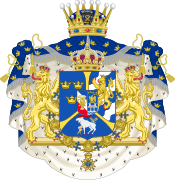 |
Arms of Carl Gustaf as Duke of Jämtland (1950-1973) |
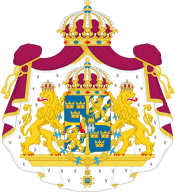 |
Arms of Carl XVI Gustaf used since he became king. |
Patronages
Carl XVI Gustaf is a patron of many organizations. This means he supports them and helps raise awareness for their work. Some of these include:
- African Medical and Research Foundation Sweden (AMREF)
- Swedish Central Association for Sports Promotion
- Friends of the Nationalmuseum
- Swedish Outdoor Association
- Global Child Forum
- Royal Automobile Club
- Swedish Cancer Society
- Royal Swedish Academy of Sciences
- The Natural Step Foundation
- Keep Sweden Tidy Foundation
- Swedish Tourist Association
- The Guides and Scouts of Sweden
- Swedish Bible Society
- Swedish Red Cross
- World Scout Foundation
- World Wide Fund for Nature Sweden (WWF)
See also
 In Spanish: Carlos XVI Gustavo de Suecia para niños
In Spanish: Carlos XVI Gustavo de Suecia para niños


